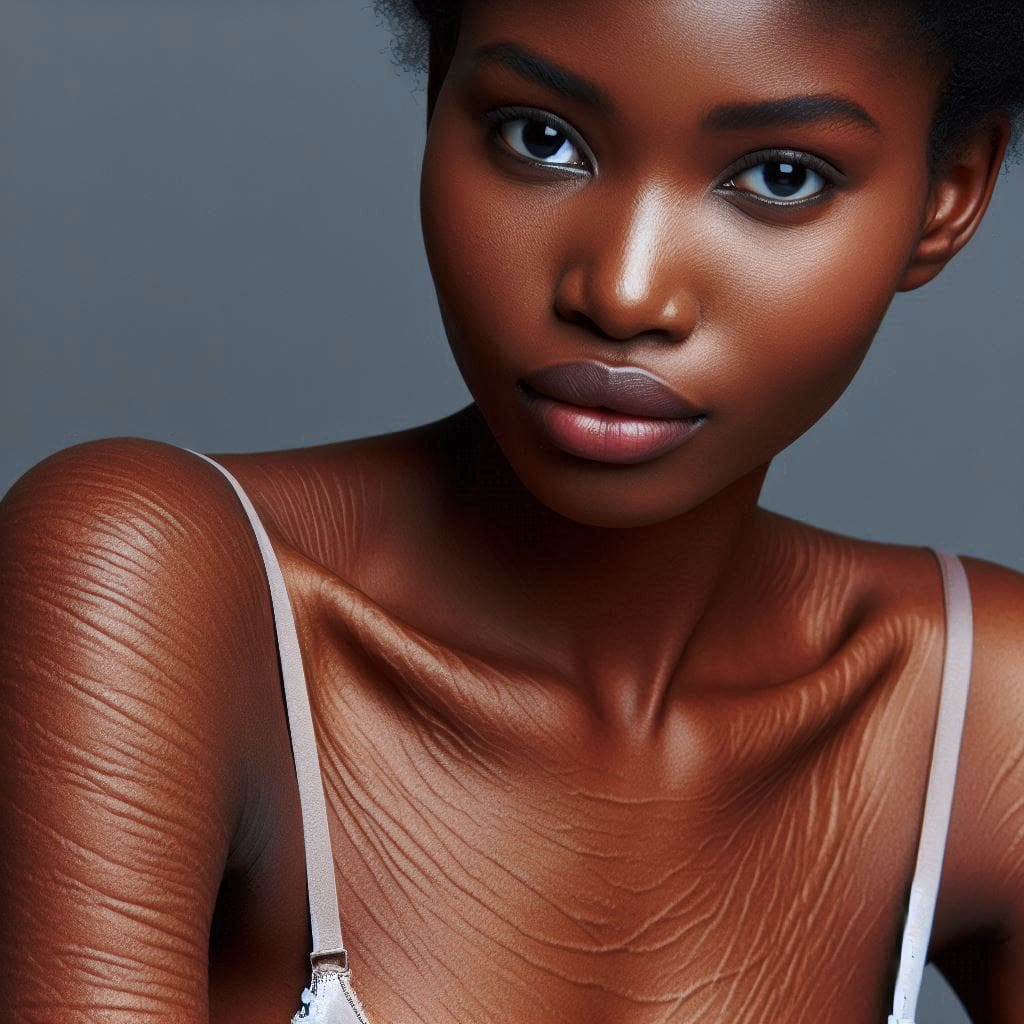
Stretch marks are those wavy lines that can appear on your skin, often on the belly, thighs, hips, breasts, and buttocks. They’re very common, affecting up to 80% of pregnant women and many people during puberty or weight gain. While they’re harmless, some people might feel self-conscious about them.
What are Stretch Marks?
Stretch marks happen when the skin stretches rapidly. This can cause the middle layer (dermis) to tear slightly. The body then tries to repair the damage with new collagen fibers, which show up as lines on the skin surface.
What Causes Stretch Marks?
These marks happen when your skin stretches rapidly. This can be caused by:
- Pregnancy: The growing baby stretches your belly skin.
- Growth spurts: Teenagers experience rapid growth, which can stretch their skin.
- Sudden weight gain: Gaining weight quickly can stretch your skin.
- Bodybuilding: Building muscle mass can also stretch the skin.
Additional factors that may contribute to stretch marks include:
- Genetics: If your parents or close relatives have stretch marks, you’re more likely to develop them as well.
- Corticosteroid Use: Long-term use of corticosteroid creams or medications can weaken the skin’s elasticity, increasing the risk of stretch marks.
- Medical Conditions: Certain medical conditions, such as Cushing’s syndrome and Marfan syndrome, can also cause stretch marks.
How Do Stretch Marks Affect the Skin?
Stretch marks develop in two stages:
- Inflammatory Stage: The skin stretches, causing tiny tears in the deeper layer (dermis). The area may appear red or pink and feel itchy.
- Mature Stage: The tears heal, but the skin doesn’t regain its original elasticity. The marks become indented and may appear white or silvery.
Effects of Stretch Marks on the Skin:
- Skin Sensitivity: New stretch marks can sometimes be itchy and uncomfortable, especially during the early stages when the skin is actively tearing. This itching can be irritating and make it hard to resist scratching, which can potentially worsen the marks.
- Texture Changes: These marks can alter the texture of your skin. They may feel slightly raised or indented, creating an uneven surface. This change in texture can be more noticeable in certain areas like the abdomen or thighs.
- Self-Esteem Impact: For some people, stretch marks can lead to feelings of self-consciousness and negatively impact their body image. It’s important to remember that these marks are a natural part of life for many people, and they don’t define your beauty or worth.
- Individual Variations: Everyone’s skin reacts differently. While some people experience significant itching or texture changes, others might have minimal discomfort.
How Can I Minimize Stretch Marks?

While there’s no magic eraser for stretch marks, some things can help minimize their appearance:
- Moisturize: Keeping your skin well-hydrated with lotion may help improve skin elasticity and potentially reduce the appearance of these marks.
- Healthy Diet: Eating a balanced diet rich in fruits, vegetables, and whole grains provides your skin with the nutrients it needs to stay healthy and elastic.
- Stay Hydrated: Drinking plenty of water helps keep your skin plump and hydrated, which may reduce the risk of these unwanted marks.
- Gentle Exfoliation: Exfoliating your skin gently with a scrub or brush can remove dead skin cells and promote new cell growth, making these marks less noticeable. Exfoliate 1-2 times a week to avoid irritating the skin.
- Manage Weight Gain: Gaining weight gradually during pregnancy or other situations can help minimize stretching on your skin.
- Laser Treatments: Some people opt for laser treatments for stretch marks. These can be expensive and may require multiple sessions.
- Dermatologist Options: If home treatments aren’t effective, consult a dermatologist for options like laser therapy, microdermabrasion, or chemical peels. These treatments can help reduce the appearance of these uncomfortable marks by promoting collagen and elastin production.
Living With Stretch Marks:
Stretch marks are a normal part of life for many people.
Here are some tips for embracing your skin:
- Focus on Overall Skin Health: Maintaining a healthy lifestyle with good nutrition and hydration benefits your entire body and skin.
- Love Your Body: Stretch marks don’t define your beauty. Appreciate your body for all it does.
- Talk to a Doctor: If these uncomfortable marks are causing you significant emotional distress, talk to your doctor about treatment options or support resources.
Shine From Within: More Ways to Love the Skin You’re In
Stretch marks are common, but that doesn’t mean you have to hide them.
Here are some additional ways to embrace your beautiful skin, just the way it is:
- Celebrate Your Strength: Stretch marks can be a reminder of your body’s incredible strength and resilience. They might tell a story of pregnancy, weight loss, or growth – all signs of your body’s amazing capabilities!
- Surround Yourself with Positivity: Social media can often create unrealistic beauty standards. Instead, follow body-positive accounts that celebrate all shapes and sizes. Remember, beauty comes in all forms!
- Practice Self-Love: Treat yourself with kindness and respect. Stretch marks don’t take away from your worth. You are beautiful, strong, and capable, just as you are.
Feeling Confident in Your Skin:
Stretch marks are a common skin concern, but with the right care, you can improve your skin’s appearance and feel more confident.
These uncomfortable marks don’t define your beauty. Embrace your unique body and focus on feeling healthy and comfortable in your own skin. If you have concerns about these marks or your skin health, talk to your doctor or dermatologist.



